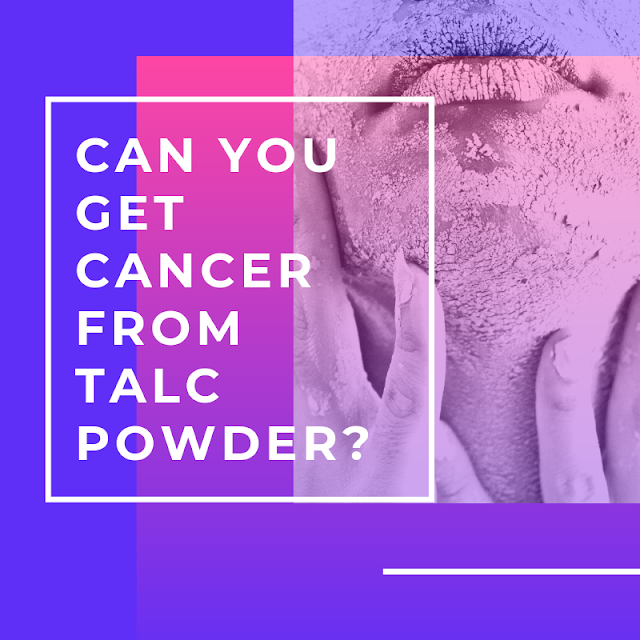Can You Get Cancer from Cosmetic Talc Powder?
Friday, September 06, 2019
Talc
powder (also known as talcum powder) has gained a bad reputation in the
cosmetic industry for the past few years alongside paraben and sulphate (e.g.
SLS/SLES). The controversy started when Johnson
& Johnson, a major manufacturer of baby powder using talc, was involved
in several lawsuits by women who claimed that their ovarian cancer was caused
by daily dusting of Johnson’s baby powder on their genital area. Aside from
ovarian cancer, there are also articles floating around the internet claiming
that talc can also cause lung cancer. Before we dig into those issues, let me
first give you more info about talc.
Talc is
a natural mineral composed of hydrated magnesium silicate. It has the
ability to absorb moisture (e.g. sweat) and reduces friction which makes it an
ideal ingredient for baby powders. Talc is also a popular filler used in powder
makeup due to its soft and silky texture.
In
its natural form, talc may or may not contain asbestos – a mineral known to cause lung cancer. This is due to the
fact that talc and asbestos are naturally occurring minerals that may be found
in close proximity in the earth, which explains the potential for contamination
during its mining. This means that talc itself is not carcinogenic, rather it’s
the talc that is contaminated with asbestos.
The
good news is that cosmetic-grade talc
does not contain asbestos. Cosmetic regulating bodies have imposed stricter
standards stating that talc used in cosmetic products must be free from
asbestos. Bigger cosmetic brands that use talc in their products have already
taken the initiative to only use asbestos-free talc. For example, Unilever
assures their consumers that they only use cosmetic-grade (asbestos-free) talc in all of their personal care products. However, for small scale cosmetic
manufacturers, we can’t be assured that they will always comply with regards to
the use of cosmetic-grade talc in their products.
Now
let’s go back to our two main issues.
Does talc powder cause lung cancer?
According
to the American Cancer Society,
“no increased risk of lung cancer has been reported with the use of cosmetic
talcum powder”. Again, I would like to emphasize that they’re referring to
cosmetic-grade talc.
You
will only be susceptible to lung cancer if you are a miner working at a
talc-mining site where you can be exposed to extremely large amount of talc
contaminated with asbestos over a long period of time. For us consumers,
this won’t be a problem since talc must be purified from any impurities (e.g.
asbestos) before making its way to our cosmetics. Not to mention that when we
use talc in baby powder or makeup, we don’t really inhale it in very large
amount for extended period of time unlike the talc miners.
Does talc powder cause ovarian cancer?
The
public concern over perineal (genital area) talc powder dusting and its
relation to ovarian cancer has been a topic of debate for many years. In fact,
for the past 20 years, several studies have been conducted with regards to this
issue but evidences are still considered inconclusive (unproven). Some experts
say that finding talc particles in ovarian cancer tissues do not necessarily
mean that talc is the cause of cancer. There are many other risk factors that
can cause ovarian cancer such as genetics (e.g. family history), diet and
lifestyle choices. Those said factors are not even mentioned on previously
conducted studies and instead just focuses on asking women participants if they
use talc powder on their genital area or not. Due to limited evidences from
human studies, the International Agency
for Research on Cancer (IARC) classifies the genital use of talc powder as
“possibly carcinogenic to humans”. “Possibly” which means that it may or
may not cause or increase the risk of having ovarian cancer. In other words, it
is not yet certain whether talc powder can cause ovarian cancer.
There
are still ongoing researches being conducted to find stronger evidences linking
ovarian cancer to talc powder. Until a final conclusion is presented, it is a
matter of personal choice whether you want to avoid applying talc powder on
genital area. However, if you have an increased risk of getting ovarian cancer
due to a family history of the disease, then I highly advise that you avoid
using talc powder on your genital area, just to be on the safe side.
Take
note that the existing research studies only mention about genital application
of talc powder, which means that using talc-based powder on other parts of the
body or face will not cause any harm.
Any alternatives to cosmetic talc?
If
you are a cosmetic formulator and you want to make a talc-free baby powder or
powder makeup formulation, then you need to use an alternative raw material
that has similar properties with talc. We’re looking for powders with silky
texture, very fine particle size and has oil/moisture absorption capabilities.
Example of these materials are boron nitride, sericite mica, silk powder and
kaolin clay.
You
can also use plant-based starches like cornstarch, arrowroot powder and rice
powder as alternatives to talc. However, since they are food-grade powders,
they have shorter shelf life and more prone to microbial contamination. They
also have larger particle size than talc so they need to be grinded prior to
use in cosmetics so that they would have finer and smoother texture when
applied on skin.
References:
Is
talc bad for you? Retrieved from https://thebeautybrains.com/2006/09/is-talc-bad-for-you/
Perineal
Talc Use and Ovarian Cancer: A Critical Review. Retrieved from https://www.ncbi.nlm.nih.gov/pmc/articles/PMC3621109/
Talc.
Retrieved from https://www.fda.gov/cosmetics/cosmetic-ingredients/talc
Talcum
Powder and Cancer. Retrieved from https://www.cancer.org/cancer/cancer-causes/talcum-powder-and-cancer.html
P.S.
To always get the latest blog updates, don’t forget to follow me on Facebook.










0 comments